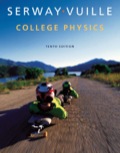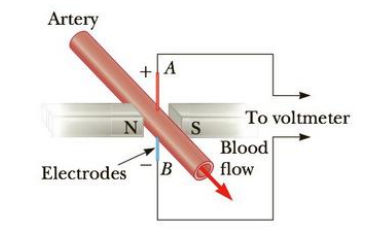
EBK COLLEGE PHYSICS
10th Edition
ISBN: 8220100853050
Author: Vuille
Publisher: CENGAGE L
expand_more
expand_more
format_list_bulleted
Concept explainers
Textbook Question
Chapter 19, Problem 69AP
Using an

Figure P19.69
Expert Solution & Answer
Trending nowThis is a popular solution!

Students have asked these similar questions
Two complex values are z1=8 + 8i, z2=15 + 7 i. z1∗ and z2∗ are the complex conjugate values.
Any complex value can be expessed in the form of a+bi=reiθ. Find r and θ for (z1-z∗2)/z1+z2∗. Find r and θ for (z1−z2∗)z1z2∗ Please show all steps
An electromagnetic wave is traveling through vacuum in the positive x direction. Its electric field vector is given by E=E0sin(kx−ωt)j^,where j^ is the unit vector in the y direction. If B0 is the amplitude of the magnetic field vector, find the complete expression for the magnetic field vector B→ of the wave.
What is the Poynting vector S(x,t), that is, the power per unit area associated with the electromagnetic wave described in the problem introduction?
Give your answer in terms of some or all of the variables E0, B0, k, x, ω, t, and μ0. Specify the direction of the Poynting vector using the unit vectors i^, j^, and k^ as appropriate. Please explain all steps
Another worker is performing a task with an RWL of only 9 kg and is lifting 18 kg, giving him an LI of 2.0 (high risk).
Questions:What is the primary issue according to NIOSH?Name two factors of the RWL that could be improved to reduce risk.If the horizontal distance is reduced from 50 cm to 30 cm, how does the HM change and what effect would it have?
Chapter 19 Solutions
EBK COLLEGE PHYSICS
Ch. 19.3 - A charged particle moves in a straight line...Ch. 19.3 - The north-pole end of a bar magnet is held near a...Ch. 19.4 - As a charged particle moves freely in a circular...Ch. 19.6 - A square and a circular loop with the same area...Ch. 19.8 - Which of the following actions would double the...Ch. 19.8 - Prob. 19.6QQCh. 19 - Prob. 1CQCh. 19 - Prob. 2CQCh. 19 - How can the motion of a charged particle be used...Ch. 19 - Prob. 4CQ
Ch. 19 - The following statements are related to the force...Ch. 19 - Will a nail be attracted to either pole of a...Ch. 19 - Figure CQ19.7 shows a coaxial cable carrying...Ch. 19 - A magnet attracts a piece of iron. The iron can...Ch. 19 - Figure CQ19.9 shows four positive charges, A, B,...Ch. 19 - Is the magnetic field created by a current loop...Ch. 19 - Suppose you move along a wire at the same speed as...Ch. 19 - Why do charged particles from outer space, called...Ch. 19 - A hanging Slinky toy is attached to a powerful...Ch. 19 - How can a current loop he used to determine the...Ch. 19 - Prob. 15CQCh. 19 - Figure CQ19.16 shows four permanent magnets, each...Ch. 19 - Two charged particles are projected in the same...Ch. 19 - Prob. 18CQCh. 19 - A magnetic field exerts a torque on each of the...Ch. 19 - Consider an electron near the Earths equator. In...Ch. 19 - (a) Find the direction of the force on a proton (a...Ch. 19 - Find the direction of the magnetic field acting on...Ch. 19 - Prob. 4PCh. 19 - A laboratory electromagnet produces a magnetic...Ch. 19 - Prob. 6PCh. 19 - Electrons and protons travel from the Sun to the...Ch. 19 - An oxygen ion (O+) moves in the xy-plane with a...Ch. 19 - A proton moving at 4.00 106 m/s through a...Ch. 19 - Sodium ions (Na+) move at 0.851 m/s through a...Ch. 19 - At the equator, near the surface of Earth, the...Ch. 19 - A proton travels with a speed of 5.02 106 m/s at...Ch. 19 - An electron moves in a circular path perpendicular...Ch. 19 - Figure P19.14a is a diagram of a device called a...Ch. 19 - Prob. 15PCh. 19 - A mass spectrometer is used to examine the...Ch. 19 - Jupiters magnetic field occupies a volume of space...Ch. 19 - Electrons in Earths upper atmosphere have typical...Ch. 19 - Prob. 19PCh. 19 - A proton (charge +e, mass mp), a deuteron (charge...Ch. 19 - A particle passes through a mass spectrometer as...Ch. 19 - In Figure P19.2, assume in each case the velocity...Ch. 19 - A current I = 15 A is directed along the positive...Ch. 19 - A straight wire carrying a 3.0-A current is placed...Ch. 19 - In Figure P19.3, assume in each case the velocity...Ch. 19 - A wire having a mass per unit length of 0.500 g/cm...Ch. 19 - A wire carries a current of 10.0 A in a direction...Ch. 19 - At a certain location, Earth has a magnetic field...Ch. 19 - A wire with a mass of 1.00 g/cm is placed on a...Ch. 19 - Mass m = 1.00 kg is suspended vertically at rest...Ch. 19 - Consider the system pictured in Figure P19.31. A...Ch. 19 - A metal rod of mass m carrying a current I glides...Ch. 19 - In Figure P19.33, the cube is 40.0 cm on each...Ch. 19 - A horizontal power line of length 58 m carries a...Ch. 19 - A wire is formed into a circle having a diameter...Ch. 19 - A current of 17.0 mA is maintained in a single...Ch. 19 - An eight-turn coil encloses an elliptical area...Ch. 19 - A current-carrying rectangular wire loop with...Ch. 19 - A 6.00-turn circular coil of wire is centered on...Ch. 19 - The orientation of small satellites is often...Ch. 19 - Along piece of wire with a mass of 0.100 kg and a...Ch. 19 - A rectangular loop has dimensions 0.500 m by 0.300...Ch. 19 - A lightning bolt may carry a current of 1.00 104...Ch. 19 - A long, straight wire going through the origin is...Ch. 19 - Neurons in our bodies carry weak currents that...Ch. 19 - In 1962 measurements of the magnetic field of a...Ch. 19 - A cardiac pacemaker can be affected by a static...Ch. 19 - The two wires shown in Figure P19.48 are separated...Ch. 19 - Prob. 49PCh. 19 - Two long, parallel wires carry currents of I1 =...Ch. 19 - Two long, parallel wires carry currents of I1 =...Ch. 19 - Prob. 52PCh. 19 - The magnetic field 40.0 cm away from a long,...Ch. 19 - Prob. 54PCh. 19 - Prob. 55PCh. 19 - Prob. 56PCh. 19 - A wire with a weight per unit length of 0.080 N/m...Ch. 19 - In Figure P19.58 the current in the long, straight...Ch. 19 - A long solenoid that has 1.00 103 turns uniformly...Ch. 19 - Prob. 60PCh. 19 - It is desired to construct a solenoid that will...Ch. 19 - Certain experiments must be performed in the...Ch. 19 - Ail electron is moving at a speed of 1.0 104 in/s...Ch. 19 - Figure P19.64 is a setup that can be used to...Ch. 19 - Two coplanar and concentric circular loops of wire...Ch. 19 - An electron moves in a circular path perpendicular...Ch. 19 - Prob. 67APCh. 19 - A 0.200-kg metal rod carrying a current of 10.0 A...Ch. 19 - Using an electromagnetic flowmeter (Fig. P19.69),...Ch. 19 - A uniform horizontal wire with a linear mass...Ch. 19 - Prob. 71APCh. 19 - Two long, parallel wires, each with a mass per...Ch. 19 - Protons having a kinetic energy of 5.00 MeV are...Ch. 19 - A straight wire of mass 10.0 g and length 5.0 cm...Ch. 19 - A 1.00-kg ball having net charge Q = 5.00 C is...Ch. 19 - Two long, parallel conductors separated by 10.0 cm...
Knowledge Booster
Learn more about
Need a deep-dive on the concept behind this application? Look no further. Learn more about this topic, physics and related others by exploring similar questions and additional content below.Similar questions
- Two complex values are z1=8 + 8i, z2=15 + 7 i. z1∗ and z2∗ are the complex conjugate values. Any complex value can be expessed in the form of a+bi=reiθ. Find r and θ for z1z2∗. Find r and θ for z1/z2∗? Find r and θ for (z1−z2)∗/z1+z2∗. Find r and θ for (z1−z2)∗/z1z2∗ Please explain all steps, Thank youarrow_forwardAn ac series circuit consists of a voltage source of frequency 60 Hz and voltage amplitude V, a 505-Ω resistor, and a capacitor of capacitance 7.2 μF. What must be the source voltage amplitude V for the average electrical power consumed in the resistor to be 236 W? There is no inductance in the circuit.arrow_forwardAn L−R−C series circuit has R= 280 Ω . At the frequency of the source, the inductor has reactance XLL= 905 Ω and the capacitor has reactance XC= 485 Ω . The amplitude of the voltage across the inductor is 445 V . What is the amplitude of the voltage across the resistor and the capacitor? What is the voltage amplitude of the source? What is the rate at which the source is delivering electrical energy to the circuit?arrow_forward
- A 0.185 H inductor is connected in series with a 98.5 Ω resistor and an ac source. The voltage across the inductor is vL=−(12.5V)sin[(476rad/s)t]vL. Derive an expression for the voltage vR across the resistor. Express your answer in terms of the variables L, R, VL (amplitude of the voltage across the inductor), ω, and t. What is vR at 2.13 ms ? Please explain all stepsarrow_forwardA worker lifts a box under the following conditions:Horizontal distance (H): 30 cmInitial height (V): 60 cmVertical travel (D): 50 cmTorso rotation (A): 30°Frequency: 3 times/minute for 1 hourGrip: Good Question:What is the RWL for this task?What does this value mean in terms of occupational safety?arrow_forwardCan someone helparrow_forward
- Can someone help mearrow_forward3. Four identical small masses are connected in a flat perfect square. Rank the relative rotational inertias (IA, IB, IC) about the three axes of rotation shown. Axes A and B are in the plane of the square, and axis C is perpendicular to the plane, through mass m1. ΙΑ IB m2 m1 m3 Ic m4 (a) IAarrow_forwardConsider the circuit shown in the figure below. (Assume L = 5.20 m and R2 = 440 Ω.) (a) When the switch is in position a, for what value of R1 will the circuit have a time constant of 15.4 µs? (b) What is the current in the inductor at the instant the switch is thrown to position b?arrow_forwardCan someone helparrow_forwardCan someone help mearrow_forwardA particle in a box between x=0 and x=6 has the wavefunction Psi(x)=A sin(2πx). How muchenergy is required for the electron to make a transition to Psi(x)= A’ sin(7π x/3). Draw anapproximate graph for the wavefunction. Find A and A'arrow_forwardarrow_back_iosSEE MORE QUESTIONSarrow_forward_ios
Recommended textbooks for you
 Physics for Scientists and Engineers, Technology ...PhysicsISBN:9781305116399Author:Raymond A. Serway, John W. JewettPublisher:Cengage Learning
Physics for Scientists and Engineers, Technology ...PhysicsISBN:9781305116399Author:Raymond A. Serway, John W. JewettPublisher:Cengage Learning Principles of Physics: A Calculus-Based TextPhysicsISBN:9781133104261Author:Raymond A. Serway, John W. JewettPublisher:Cengage Learning
Principles of Physics: A Calculus-Based TextPhysicsISBN:9781133104261Author:Raymond A. Serway, John W. JewettPublisher:Cengage Learning
 Physics for Scientists and Engineers with Modern ...PhysicsISBN:9781337553292Author:Raymond A. Serway, John W. JewettPublisher:Cengage Learning
Physics for Scientists and Engineers with Modern ...PhysicsISBN:9781337553292Author:Raymond A. Serway, John W. JewettPublisher:Cengage Learning College PhysicsPhysicsISBN:9781305952300Author:Raymond A. Serway, Chris VuillePublisher:Cengage Learning
College PhysicsPhysicsISBN:9781305952300Author:Raymond A. Serway, Chris VuillePublisher:Cengage Learning College PhysicsPhysicsISBN:9781285737027Author:Raymond A. Serway, Chris VuillePublisher:Cengage Learning
College PhysicsPhysicsISBN:9781285737027Author:Raymond A. Serway, Chris VuillePublisher:Cengage Learning

Physics for Scientists and Engineers, Technology ...
Physics
ISBN:9781305116399
Author:Raymond A. Serway, John W. Jewett
Publisher:Cengage Learning

Principles of Physics: A Calculus-Based Text
Physics
ISBN:9781133104261
Author:Raymond A. Serway, John W. Jewett
Publisher:Cengage Learning


Physics for Scientists and Engineers with Modern ...
Physics
ISBN:9781337553292
Author:Raymond A. Serway, John W. Jewett
Publisher:Cengage Learning

College Physics
Physics
ISBN:9781305952300
Author:Raymond A. Serway, Chris Vuille
Publisher:Cengage Learning

College Physics
Physics
ISBN:9781285737027
Author:Raymond A. Serway, Chris Vuille
Publisher:Cengage Learning
Magnets and Magnetic Fields; Author: Professor Dave explains;https://www.youtube.com/watch?v=IgtIdttfGVw;License: Standard YouTube License, CC-BY